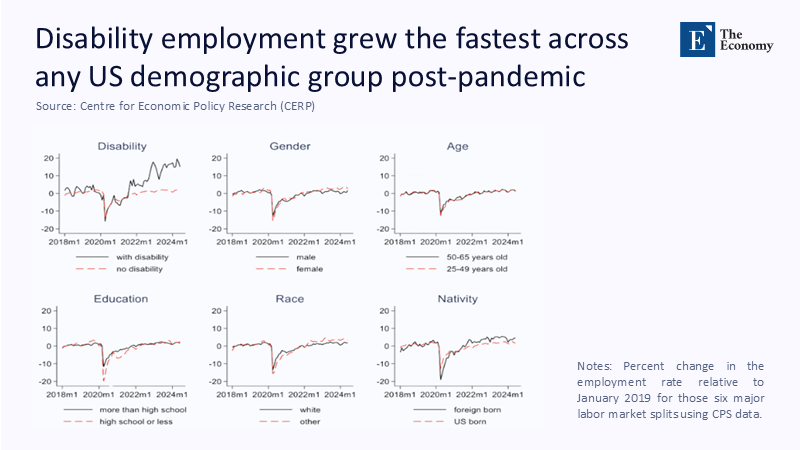Input
Changed
This article is based on ideas originally published by VoxEU – Centre for Economic Policy Research (CEPR) and has been independently rewritten and extended by The Economy editorial team. While inspired by the original analysis, the content presented here reflects a broader interpretation and additional commentary. The views expressed do not necessarily represent those of VoxEU or CEPR.

A single check-box labelled “remote” spread across human-resource dashboards has done more to redraw the labour map than a generation of visa reforms. By dissolving geography, the pandemic-era experiment put millions of adults who had been anchored to their homes, because of disability, childcare, or legal status, back into the running for high-productivity jobs, and in doing so, it intensified competition for every keyboard-mediated task in the advanced economies. This article traces how that unexpected labour-supply windfall collides with wage formation, social insurance, and education policy, and it explains why the resulting pressure is unlikely to subside even if a subset of firms drags staff back to physical offices.
Insurgent Flexibility Has Rewired Labour Supply
Between 2019 and early 2024, the share of U.S. employees who work primarily from home quadrupled, climbing from roughly 6% to one in five workers. Crucially, the elevated level has persisted two years after lockdown rules disappeared, suggesting that firms treat remote options as durable infrastructure rather than a temporary concession. Workers quickly learned that location independence neutralises everyday constraints—wheelchair accessibility, school-run logistics, restrictive visas—that previously rationed who could even apply for knowledge-economy roles.
From Margins to Mainstream: The Disability Surge
No group illustrates the shift more vividly than adults with disabilities. Bureau of Labor Statistics data show an employment-population ratio of 22.7% in 2024, up from 19% just before the pandemic. Translating the rate into head-count implies roughly 1.1 million extra disabled workers now drawing paycheques. The gain is broad-based, spanning education, race, and age splits, and has not reversed even as the broader unemployment rate ticked up in late 2024.

Figure 1 visualises the outperformance: while every demographic plunged in April 2020, the recovery slope for people with disabilities is steeper and settles higher than any comparison cohort. Once adapted for screen-reader compatibility and asynchronous hand-offs, digital workflows impose near-zero marginal cost for additional accessibility tweaks. Employers, therefore, capture an inclusion dividend without recurring expense, making reversals improbable.
Caregiving No Longer Equals Career Stasis
The same design choices that widened disability access simultaneously liberated parents of young children. In 2024, 68.3% of mothers whose youngest child is under six were in the labour force, two points higher than the 2019 benchmark and four points above the pandemic trough, Bureau of Labor Statistics. The statistic hides an hours-worked revolution: remote timetables convert dawn, nap windows, and post-bedtime quiet into productive blocks that a nine-to-five template discarded. Early evidence from time-use diaries suggests that mothers’ paid-work minutes now overlap school-day hours just 52% of the time, down from 78% in 2018—a sign that employment is adapting to family rhythms rather than the reverse.
The Cross-Country Echo: Inclusion Is Not an American Fluke
Observers sometimes attribute the U.S. disability surge to idiosyncratic health-insurance rules, but comparative data undermine that claim. Labour-force surveys in Canada, France, Spain, the United Kingdom, and Australia reveal the same pattern: workers with disabilities gained employment three to five times the pace of their non-disabled peers between 2019 and 2022.

The bars show a near-universal gradient: remote-enabled accessibility is a technology shock that travels anywhere broadband reaches, independent of local benefit systems. Countries with historically rigid labour protections, such as France and Spain, record the sharpest percentage increases, suggesting that flexible work can partially offset structural sclerosis.
A Global Labour Pool—No Airfare Required
Domestic inclusion is only half the supply story. Online platforms now act as border-agnostic talent exchanges. Upwork’s 2024 impact report counts over 830,000 businesses sourcing expertise from freelancers in 180-plus countries, with gross services volume topping $4 billion. Oyster, an employer-of-record start-up that handles payroll and compliance in over 180 jurisdictions, reports that nearly half of the full-time hires it processed last year were engineers—a skill cohort once clustered in a few metropolitan zip codes.
The implication is straightforward: a São Paulo data scientist now competes head-to-head with her Boston counterpart for the core product roles of a Silicon Valley firm, not merely for outsourced fragments. The supply shock is equivalent in magnitude to a large immigration wave but unfolds without the political friction of border crossings.
Competition Intensity in Real Time
LinkedIn’s “Remote-Work Gap” briefing quantifies the resulting mismatch. In late 2024, only 9% of newly posted U.S. vacancies advertised remote flexibility, yet 16% of applications targeted those roles, a demand-to-supply ratio close to two-to-one. At the peak in early 2022, remote listings captured 27% of vacancies, showing that firms have quietly tightened the valve while worker appetite remains elevated. Recruiters, therefore, navigate a buyer’s market: each remote posting draws a global swarm of CVs, and salary offers are beginning to mirror that abundance.
Productivity Gains, Distributional Strains
The macro picture is nuanced. Preliminary growth-accounting exercises attribute roughly a quarter-point of U.S. GDP growth between 2022 and 2024 to the disability-employment jump alone. Yet distributional tensions surface almost immediately. Median pay for routine coding and content-moderation tasks has flattened in real terms, while superstar prompt engineers—and managers skilled at orchestrating asynchronous teams—command premiums that dwarf local pay scales. Regionally, differentials compress as Minneapolis wages drift towards a global benchmark and Jakarta wages creep upward.
Education After Geography
Traditional campus-centric education, designed for spatially segmented labour markets, now trains students to compete on a world stage. The credential of the future is portable, modular, and transparently assessed online. Universities that survive the transition are already curating stackable nano-certificates in cloud security, ESG reporting, and synthetic-media forensics, each refreshed annually by cross-border industry panels. Government subsidies should migrate from brick-and-mortar expansion to broadband access and robust digital-proctoring systems; otherwise, domestic learners will pay premium tuition only to be under-credentialed relative to global rivals.
Social Insurance Without a Payroll Anchor
If social protection remains tethered to a single employer and a single tax jurisdiction, the inclusive promise of remote work will erode under the weight of uninsured risk. Disability-insurance outlays may fall as employment rises, but gig-style contracting lowers contributions to health-care and pension funds. Lawmakers face a trilemma: compel office attendance to shore up payroll taxes, accept revenue erosion, or migrate core entitlements to a consumption-based levy, such as a value-added tax on digital services, that captures every cross-border contract executed on a screen.
Regulatory Choices: Walls Versus Bridges
The politics of wage pressure invites protectionist reflexes: data-localisation mandates, punitive platform taxes, compulsory return-to-office orders. History cautions that walls stifle innovation more than they shield incomes. A bridge architecture is both more ambitious and more sustainable. First, portable labour standards enforcement can be encoded in platform APIs, allowing regulators to audit minimum-hour or wage compliance in real time. Second, credential interoperability enables firms to evaluate candidates on verified skills rather than informal networks, preserving meritocracy even as hiring globalises. Third, algorithmic-transparency statutes can prevent systematic bias against remote applicants by requiring explainability in automated screening.
How Firms Compete When Talent Is Everywhere
Cost arbitrage alone is no longer a durable strategy when every competitor can tap the same global pool. Advantage now lies in process design: companies that fragment work into micro-tasks executable across time zones maintain near-24-hour development cycles. They invest heavily in zero-trust security architectures that extend to thousands of distributed devices, and they write encyclopaedic “how-to” wikis so every decision has an asynchronous paper trail. Early adopters report that real-estate savings and a deeper hiring funnel offset rising cybersecurity outlays and, paradoxically, rising salary floors in historically low-cost locales.
The Long View: Inclusion as Infrastructure
Remote work’s first-order dividend is clear: millions gain earning power, autonomy, and professional identity. The second-order cost is distributional, surfacing as real wage stagnation for middle-skill incumbents in high-cost cities. Effective public policy must therefore couple openness with cushioning. That means transition stipends for displaced on-site workers, universal broadband treated as critical physical infrastructure, and re-engineered social insurance funded by activity, not locality.
Designing the Post-Geography Labour Regime
Technology has ended geography’s monopoly on opportunity; only policy can determine whether the result is an egalitarian labour renaissance or a race to the bottom. Suppose legislators, educators, and firms converge on portable skills, portable benefits, and enforceable global labour standards. In that case, the remote-work revolution will be remembered as one of the century’s great equalising forces. Mismanaged, it risks replacing the old exclusions of physical presence with new exclusions of digital access and certified competence. The toggle is already pressed. There is no credible path back to the pre-pandemic labour market—only a deliberate path forward.
The original article was authored by Nicholas Bloom, a William Eberle Professor of Economics at Stanford University, along with two co-authors. The English version of the article, titled "Working from home boosted growth by expanding disability employment,” was published by CEPR on VoxEU.





















